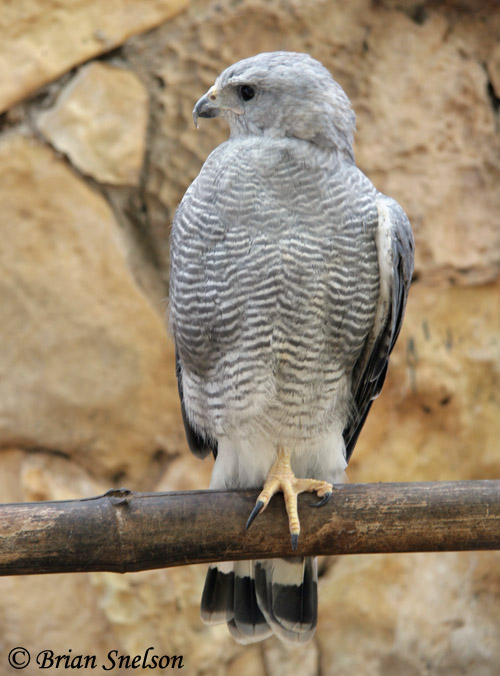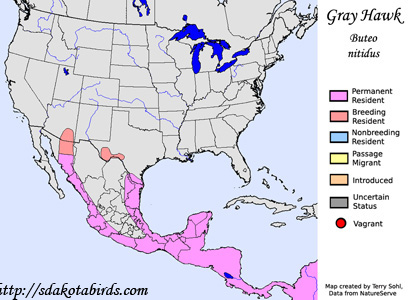| Length: 17 inches | Wingspan: 34 inches | Seasonality: Non-resident in South Dakota |
| ID Keys: Adults unique n plumage, with gray upperparts, gray-barred underparts, and a banded black and white tail | ||
 The
Gray Hawk is a tropical hawk that just reaches the United States in southern
Arizona and Texas. Even there they are very uncommon, with numbers of
nesting birds in the U.S. a few hundred at the very most. They are
rather unique in plumage for a Buteo hawk, with slate-gray upperparts, and a
finely barred, gray belly and chest. Their range extends from the
southern U.S., southward through Mexico and Central America, and into much
of northern South America.
The
Gray Hawk is a tropical hawk that just reaches the United States in southern
Arizona and Texas. Even there they are very uncommon, with numbers of
nesting birds in the U.S. a few hundred at the very most. They are
rather unique in plumage for a Buteo hawk, with slate-gray upperparts, and a
finely barred, gray belly and chest. Their range extends from the
southern U.S., southward through Mexico and Central America, and into much
of northern South America.
Habitat: Gray Hawks can be found in a variety of semi-open habitats throughout their tropical range, often in areas with openings interspersed with dense brush. In the United States portion of their range, they are found almost exclusively in riparian areas, using large riparian trees such as cottonwoods for nesting.
Diet: Feeds on a variety of small animals, many lizards and small birds, as well as snakes, rodents and other small mammals, frogs, and large insects.
Behavior: Gray Hawks are very agile and nimble hunters, well adapted to hunting in brushy and forested habitats. They will sit on a perch and look for prey, making fast direct flights when prey is spotted. They are adept at flying through relatively thick brush and forest canopies in search of prey. They will also slowly circle or fly low in and around forest areas in search of prey.
Nesting: The nest of a Gray Hawk is usually built within the lower canopy of a tree. It is built of sticks with a lining of leaves or moss. Both the male and female will incubate the eggs, and both sexes will also help to raise the young.
Song: Gray Hawks have a long series of whistled calls when displaying.
Migration: Nearly all birds in the U.S. part of their summer range retreat southward into Mexico for the winter. A few may linger near the Mexican border. Considered a permanent resident throughout most of the rest of their range.
Interactive eBird Map: Click here to access an interactive eBird map of Gray Hawk sightings
Similar Species: Quite distinctive in plumage from other Buteo hawks if seen well. Possibly confused with Northern Goshawk.
Conservation Status: There are currently no perceived major threats to Gray Hawk populations, and Birdlife International cites it as a species of "Least Concern".
Further Information: 1) Cornell's Neotropical Birds - Gray Hawk
2) AvianWeb.com - Gray Hawk
3) IUCN Red List - Gray Hawk
Photo Information: Photo by Brian Snelson - November 6th, 2007 - Yucatan, Mexico - Photo licensed under Creative Commons Attribution 2.0 Generic License
| Click below for a higher-resolution map |
 |
| South Dakota Status: Non-resident in South Dakota |
Additional Gray Hawk Photos (coming soon!!)
